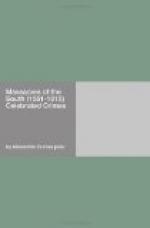The next day, at roll-call, a sergeant of another company, one Allien, a cooper by trade, taunted one of the men with having carried a pitchfork the day before, in disobedience to orders. He replied that the mayor had permitted him to carry it; Allien not believing this, proposed to some of the men to go with him to the mayor’s and ask if it were true. When they saw M. Marguerite, he said that he had permitted nothing of the kind, and sent the delinquent to prison. Half an hour later, however, he gave orders for his release.
As soon as he was free he set off to find his comrades, and told them what had occurred: they, considering that an insult to one was an insult to the whole company, determined on having satisfaction at once, so about eleven o’clock P.M. they went to the cooper’s house, carrying with them a gallows and ropes ready greased. But quietly as they approached, Allien heard them, for his door being bolted from within had to be forced. Looking out of the window, he saw a great crowd, and as he suspected that his life was in danger, he got out of a back window into the yard and so escaped. The militia being thus disappointed, wreaked their vengeance on some passing Protestants, whose unlucky stars had led them that way; these they knocked about, and even stabbed one of them three times with a knife.
On the 22nd April, 1790, the royalists—that is to say, the Catholics—assumed the white cockade, although it was no longer the national emblem, and on the 1st May some of the militia who had planted a maypole at the mayor’s door were invited to lunch with him. On the 2nd, the company which was on guard at the mayor’s official residence shouted several times during the day, “Long live the king! Up with the Cross and down with the black throats!” (This was the name which they had given to the Calvinists.) “Three cheers for the white cockade! Before we are done, it will be red with the blood of the Protestants!” However, on the 5th of May they ceased to wear it, replacing it by a scarlet tuft, which in their patois they called the red pouf, which was immediately adopted as the Catholic emblem.
Each day as it passed brought forth fresh brawls and provocations: libels were invented by the Capuchins, and spread abroad by three of their number. Meetings were held every day, and at last became so numerous that the town authorities called in the aid of the militia-dragoons to disperse them. Now these gatherings consisted chiefly of those tillers of the soil who are called cebets, from a Provencal word cebe, which means “onion,” and they could easily be recognised as Catholics by their red pouf, which they wore both in and out of uniform. On the other hand, the dragoons were all Protestants.
However, these latter were so very gentle in their admonitions, that although the two parties found themselves, so to speak, constantly face to face and armed, for several days the meetings were dispersed without bloodshed. But this was exactly what the cebets did not want, so they began to insult the dragoons and turn them into ridicule. Consequently, one morning they gathered together in great numbers, mounted on asses, and with drawn swords began to patrol the city.




